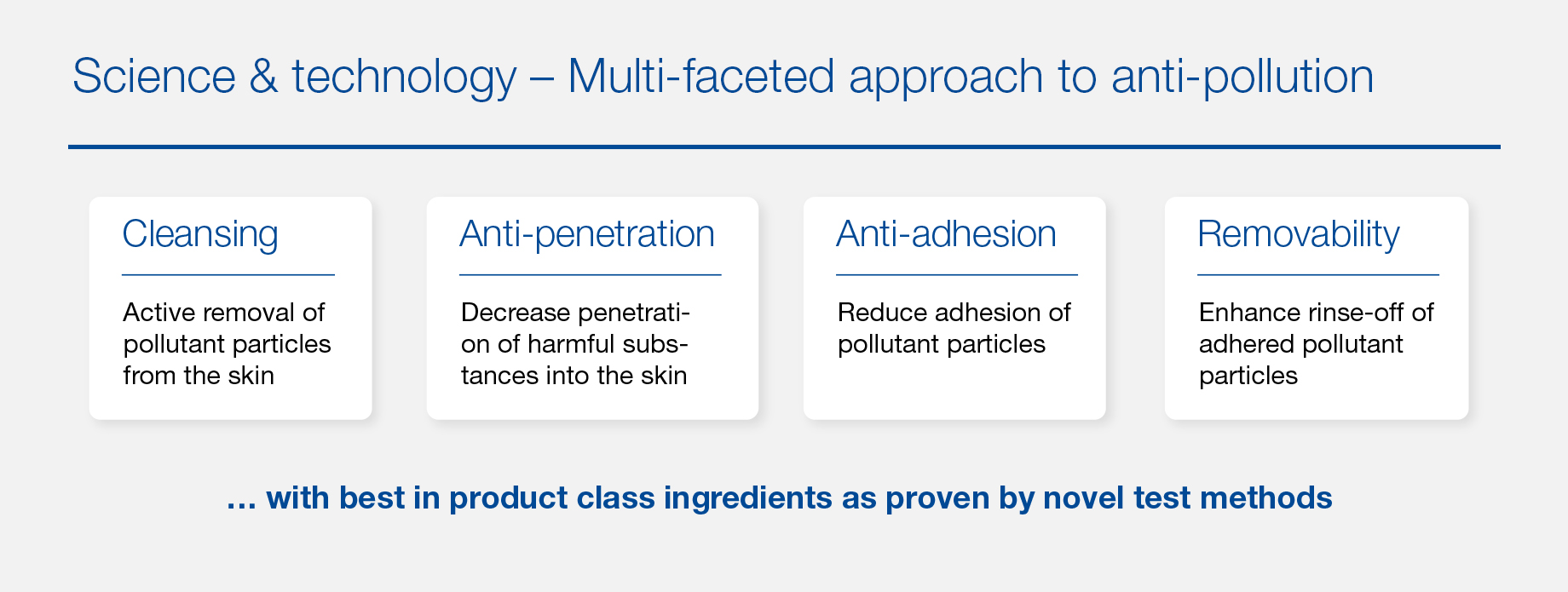
Trends & research
Safeguarding the skin against pollution-induced damage
Every day our skin is exposed to harmful pollutants. Dr. Philipp-Dormston, dermatologist and anti-pollution expert, explains how to best protect the skin and reviews BASF’s latest approach.
Dr. Philipp-Dormston, what is “pollution”?
Most people will think of air pollution, like exhaust fumes and smog – but from a scientific point of view, the definition of the term is much broader. Besides human-made air pollution, it includes things like pollen, dust, sunlight, and extreme heat or cold.
Where does pollution occur?
Pollution is exceptionally high in large urban areas; however, it is not only a concern for people living in megacities like Hong Kong and New York. Coal factories, for example, are often located in rural areas. Additionally, contaminants originally emitted in cities can travel over large distances because both gases and microparticles are suspended matter. Overall, pollution can pose a problem for anyone, particularly those with sensitive skin.
What are the consequences if the skin is exposed to pollutants over a long period?
Pollutants can not only activate pre-existing skin conditions or diseases, but even damage otherwise healthy skin. If they get on the skin’s surface or into the skin's superficial layers, pollutants can cause inflammation, which also indirectly damages the deeper skin layers. Over a long period, the skin barrier starts to deteriorate and loses its protective function. In turn, even more air pollutants and small particles can get into the skin, creating a vicious cycle. And we are not only talking about cosmetic effects such as wrinkles, fine lines, brown spots, and skin discoloration; pollution can have medical consequences too, like promoting skin irritation and reddening. If the skin barrier is damaged by pollutants, the probability of a bacterial or viral infection also increases.
How would you evaluate particulate pollutants’ risks compared to other environmental influences, such as UV exposure or harsh weather conditions?
For me, two factors make particulate pollutants especially dangerous. First, we are permanently exposed to them: you can avoid sunlight, but micro and nanoparticles enter the room as soon as you open a window or turn on the air conditioning. Secondly, the damage is not directly visible. In the event of sunburn or frost bite, the effects on the skin are immediately apparent. Pollutants damage the skin more slowly and gradually. So, it is essential to protect the skin properly.
What are the best ways to protect the skin against particulate pollutants?
Strong, healthy skin is vital, and the skin barrier function needs to be as intact as possible. This is important as particles do not usually penetrate through intact skin. We recommend people keep their skin moisturized and in good condition to prevent micro-leakages where pollutants could enter. Some substances adhering to particles can seep into the skin and cause further damage. One typical effect is that they can generate free radicals and oxidative stress, leading to skin damage and premature aging. Antioxidants are therefore vital to reduce the impact.
What role do skin care products play? Is there a “one-size-fits-all” approach?
In drugstores, consumers are presented with a range of solutions, and the wide variety of skin care claims can sometimes be confusing. Generally speaking, skin care products based on scientifically proven claims should be consumers’ first choice. And the multifaceted nature of pollution should be countered with products that offer a holistic approach and feature all the necessary protective mechanisms:
1. Reduction in the adherence of pollutants.
2. Easier removal of particles.
3. Protection against penetration and, in the event substances do enter the skin, ingredients like antioxidants that reduce the damage.
4. Protection against UV light.
What is a good starting point for skin care formulations when it comes to addressing this complex problem?
As a medical doctor and a scientist, I think that solutions should ideally address all the potential causes of skin damage. This may not always be possible, but as many of the potential factors as possible should be targeted, including reducing pollutant adhesion, penetration and oxidative stress. It is not enough to focus on one specific aspect. In addition, solutions should be evidence-based.
So, this requires a scientific test setup where individual cosmetic ingredients are analyzed to find the best approach to protecting the skin against pollution-induced damage?
An approach like this would be ideal, although it requires an enormous investment in testing. After all, lots of tests are needed to identify the best ingredients and then turn them into flawless formulations. This approach leads to the creation of tailor-made solutions that help individuals protect their skin against the dangers of pollutants, and often leads to the best possible outcomes.
You have taken a close look at BASF’s anti-pollution approach. Does it meet these scientific requirements?
Yes, it contains all the essential points that are important to me as a scientist. BASF’s approach primarily focuses on the critical factors that can protect the skin against damage from environmental pollution: anti-adhesive effect and rinse-off; anti-penetration; and cleansing. The huge number of ingredients tested shows that the search for the “screening hit”, which is the best possible substance for each problem, was very detailed and extensive. Moreover, the research team did not stop its work when these key ingredients were found; instead, it went even further to address multiple pollution factors.
In other words, a broad and in-depth analysis is essential to develop a holistic anti-pollution concept?
Exactly. In my opinion, this concept makes the case for this well. At the start of the process, the main aspects of pollution were carefully analyzed and numerous tests were performed. This means it can be scientifically proven that the new formulations are practical and meet expectations. Although this sounds like a ready-to-use solution, it was just the first step. The team also considered important antioxidants and moisturization properties, as well as skin compatibility. Finally, the environmental aspect was addressed – after all, consumers are increasingly aware of the ecological impact of certain ingredients. One thing we should keep in mind is that consumer preferences are key, and consumers will choose the products that they perceive as best at protecting their skin from harmful substances and that cater to the trends they find important.
About
After completing his studies in medicine, Dr. Philipp-Dormston worked at renowned institutions including the University Hospital in Bonn (Germany), Harvard University in Boston (USA) and the “Klinik Links vom Rhein” in Cologne (Germany). Since 2007, he has been the medical director of the department of dermatology, dermatosurgery and allergology at the “Klinik Links vom Rhein” and owner of the private practice "DERMATOLOGIE KÖLN am Rhein”. Dr. Philipp-Dormston gives regular lectures at national and international conferences, chairs several medical expert panels and has authored numerous scientific publications.
Antipollution skincare
BASF has developed a 3-stage skin-protection and -care system to safeguard against the negative effects of pollution.
More information


